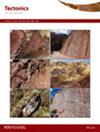Lancang Fault Assists Block Extrusion in Southeastern Tibet During Early-Middle Miocene
IF 3.6
1区 地球科学
Q1 GEOCHEMISTRY & GEOPHYSICS
引用次数: 0
Abstract
The tectonic and topographic evolution of the southeastern Tibetan Plateau based on low-temperature thermochronology data is controversial, especially whether it is tectonically- or climatically-controlled, especially along the Lancang fault (LCF) that links the flat central plateau to the west with the high relief southeastern Tibetan Plateau to the east. To explore the tectonic evolution of the LCF and its role in the tectonic and topographic evolution of the southeastern Tibetan Plateau, we carried out detailed field investigation and low-temperature thermochronology (AHe, AFT, and ZHe) analyses. Field evidence indicate that the northern LCF splits into two branches, the Yangda-Yaxu and Baqing-Leiwuqi faults, the latter striking N50°W and dipping to the SW at ∼55°, exposing >100 m-wide fault rocks composed of a fault damage zone, breccia, and gouge. New thermochronology data and thermo-kinematic modeling results suggest rapid exhumation of the region located between these two fault branches during ∼22–10 Ma at an exhumation rate of ∼1.57 km/Ma, compared to slow cooling prior to 22 Ma and since 10 Ma. We propose that internal anti-clockwise block rotation triggered rapid local exhumation, and that the final merging of different parts of the LCF during the Early-Middle Miocene assisted the southeastward escape of Sundaland, which profoundly affected the evolution of the regional geomorphology.澜沧断裂在早中新世协助了西藏东南部的块体挤压
基于低温热年代学数据的青藏高原东南部构造和地形演化存在争议,尤其是青藏高原东南部构造和地形演化是受构造控制还是受气候控制,特别是沿澜沧江断层,该断层将西部平坦的中部高原与东部地势较高的青藏高原东南部连接起来。为了探索澜沧断层的构造演化及其在青藏高原东南部构造和地形演化中的作用,我们进行了详细的野外调查和低温热时学(AHe、AFT和ZHe)分析。野外证据表明,青藏高原北部断层分为两个分支,即羊达-雅克苏断层和巴青-雷乌齐断层,后者走向为N50°W,向西南倾斜55°,出露了由断层破坏带、角砾岩和冲沟组成的宽达100米的断层岩。新的热时学数据和热运动学建模结果表明,在22-10 Ma期间,位于这两条断层分支之间的区域以1.57 km/Ma的速度快速隆升,而在22 Ma之前和10 Ma之后则冷却缓慢。我们认为,内部逆时针的块体旋转引发了局部地区的快速掘起,中新世早中期LCF不同部分的最终合并帮助了巽他兰的东南逃逸,对区域地貌的演化产生了深远的影响。
本文章由计算机程序翻译,如有差异,请以英文原文为准。
求助全文
约1分钟内获得全文
求助全文
来源期刊

Tectonics
地学-地球化学与地球物理
CiteScore
7.70
自引率
9.50%
发文量
151
审稿时长
3 months
期刊介绍:
Tectonics (TECT) presents original scientific contributions that describe and explain the evolution, structure, and deformation of Earth¹s lithosphere. Contributions are welcome from any relevant area of research, including field, laboratory, petrological, geochemical, geochronological, geophysical, remote-sensing, and modeling studies. Multidisciplinary studies are particularly encouraged. Tectonics welcomes studies across the range of geologic time.
 求助内容:
求助内容: 应助结果提醒方式:
应助结果提醒方式:


